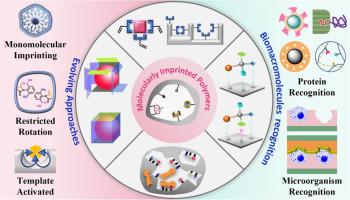当前位置:
X-MOL 学术
›
Prog. Polym. Sci.
›
论文详情
Our official English website, www.x-mol.net, welcomes your
feedback! (Note: you will need to create a separate account there.)
Rigorous recognition mode analysis of molecularly imprinted polymers—Rational design, challenges, and opportunities
Progress in Polymer Science ( IF 26.0 ) Pub Date : 2024-01-19 , DOI: 10.1016/j.progpolymsci.2024.101790 Yanxia Liu , Lulu Wang , Haitao Li , Lin Zhao , Yanfu Ma , Yagang Zhang , Jian Liu , Yen Wei
Progress in Polymer Science ( IF 26.0 ) Pub Date : 2024-01-19 , DOI: 10.1016/j.progpolymsci.2024.101790 Yanxia Liu , Lulu Wang , Haitao Li , Lin Zhao , Yanfu Ma , Yagang Zhang , Jian Liu , Yen Wei

|
Supramolecular chemistry now presents an elaborate „enabling tool“ that offers exciting opportunities for novel functional material design. One of the areas to benefit from recent advances in supramolecular chemistry is the field of molecularly imprinted polymers (MIPs), also known as “synthetic antibodies”. It uses the memory of template molecules to form tailor-made binding sites in the polymer matrix. This review provides insights from rigorous recognition mode analysis perspectives and highlights evolving approaches in MIPs. First, the principles and recognition mode of molecular imprinting technology are carefully reviewed. The similarities and major differences between MIPs and enzymes are discussed. The internal 3D structure model of MIP is depicted, the origin and consequences of binding site heterogeneity are highlighted, and methods for the optimization of the recognition degree and imprinting efficiency are summarized. The criteria for evaluating imprinting efficacy and the role of chiral recognition in molecular imprinting are discussed. Subsequently, important approaches for the design and synthesis of MIPs a reviewed. Relevant approaches include dye displacement strategy for MIP sensors, multi-functional group recognition, monomolecular imprinting using dendrimers, solvent programmable polymer (SPP) based on restricted rotation, template activated molecular imprinting strategy, molecular imprinting with click chemistry, and evolution of molecular imprinting with computational strategies. Finally, the exciting progress of MIPs for recognition of biomacromolecules such as proteins, bacteria and viruses are discussed. The goal of this review is thus to inspire new applications of MIP materials and to provide a guide for how these applications might become a reality.
中文翻译:

分子印迹聚合物的严格识别模式分析——合理设计、挑战与机遇
超分子化学现在提供了一种精心设计的“使能工具”,为新颖的功能材料设计提供了令人兴奋的机会。受益于超分子化学最新进展的领域之一是分子印迹聚合物(MIP)领域,也称为“合成抗体”。它利用模板分子的记忆在聚合物基质中形成定制的结合位点。本综述从严格的识别模式分析角度提供了见解,并重点介绍了 MIP 中不断发展的方法。首先,仔细回顾了分子印迹技术的原理和识别模式。讨论了 MIP 和酶之间的相似点和主要区别。描述了MIP的内部3D结构模型,强调了结合位点异质性的起源和后果,总结了识别度和印迹效率的优化方法。讨论了评估印迹功效的标准以及手性识别在分子印迹中的作用。随后,回顾了 MIP 设计和合成的重要方法。相关方法包括MIP传感器的染料置换策略、多功能基团识别、使用树枝状聚合物的单分子印迹、基于限制旋转的溶剂可编程聚合物(SPP)、模板激活的分子印迹策略、点击化学的分子印迹以及分子印迹的进化计算策略。最后,讨论了 MIP 在识别蛋白质、细菌和病毒等生物大分子方面取得的令人兴奋的进展。因此,本次综述的目的是激发 MIP 材料的新应用,并为这些应用如何成为现实提供指南。
更新日期:2024-01-19
中文翻译:

分子印迹聚合物的严格识别模式分析——合理设计、挑战与机遇
超分子化学现在提供了一种精心设计的“使能工具”,为新颖的功能材料设计提供了令人兴奋的机会。受益于超分子化学最新进展的领域之一是分子印迹聚合物(MIP)领域,也称为“合成抗体”。它利用模板分子的记忆在聚合物基质中形成定制的结合位点。本综述从严格的识别模式分析角度提供了见解,并重点介绍了 MIP 中不断发展的方法。首先,仔细回顾了分子印迹技术的原理和识别模式。讨论了 MIP 和酶之间的相似点和主要区别。描述了MIP的内部3D结构模型,强调了结合位点异质性的起源和后果,总结了识别度和印迹效率的优化方法。讨论了评估印迹功效的标准以及手性识别在分子印迹中的作用。随后,回顾了 MIP 设计和合成的重要方法。相关方法包括MIP传感器的染料置换策略、多功能基团识别、使用树枝状聚合物的单分子印迹、基于限制旋转的溶剂可编程聚合物(SPP)、模板激活的分子印迹策略、点击化学的分子印迹以及分子印迹的进化计算策略。最后,讨论了 MIP 在识别蛋白质、细菌和病毒等生物大分子方面取得的令人兴奋的进展。因此,本次综述的目的是激发 MIP 材料的新应用,并为这些应用如何成为现实提供指南。






























 京公网安备 11010802027423号
京公网安备 11010802027423号